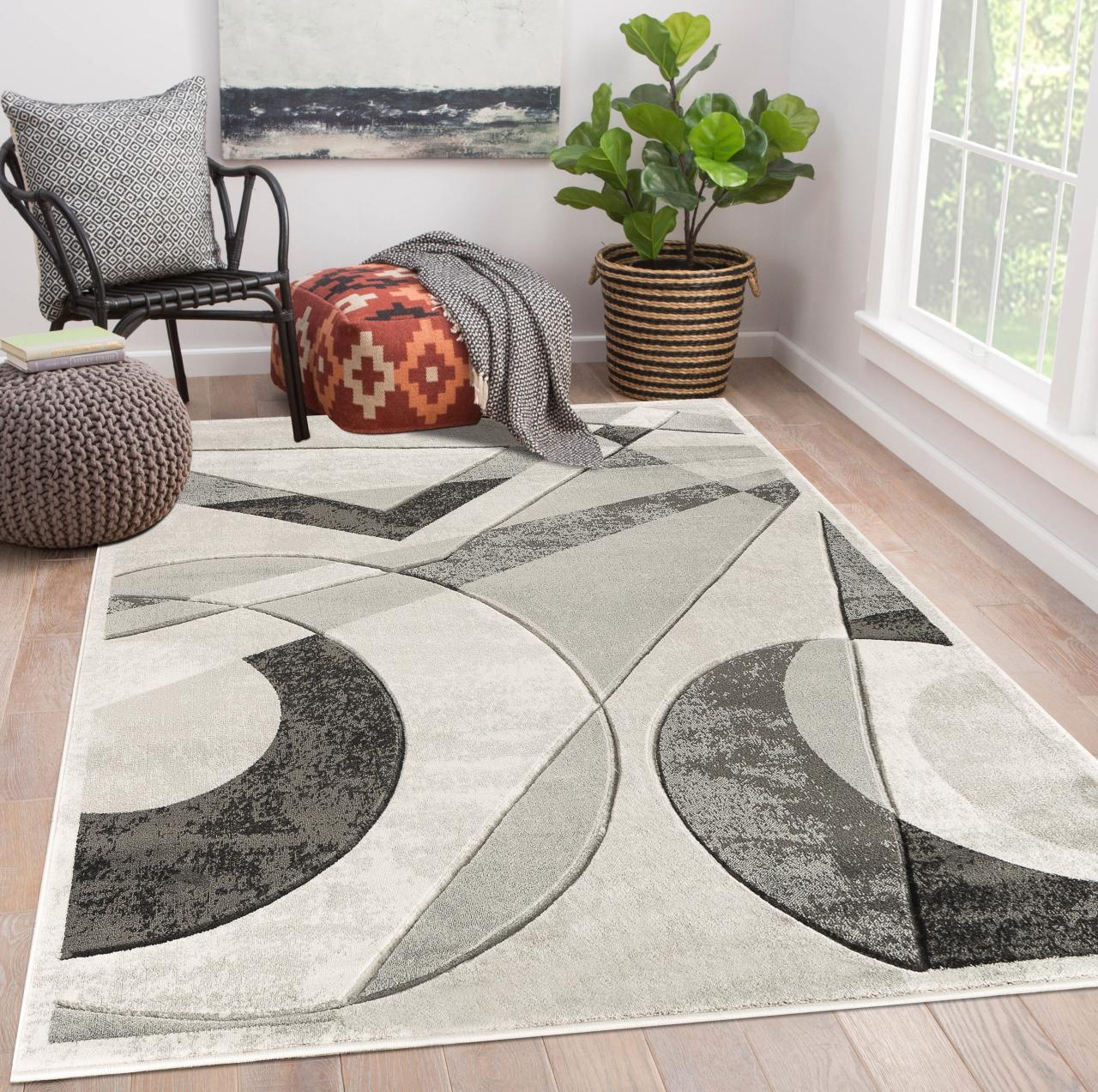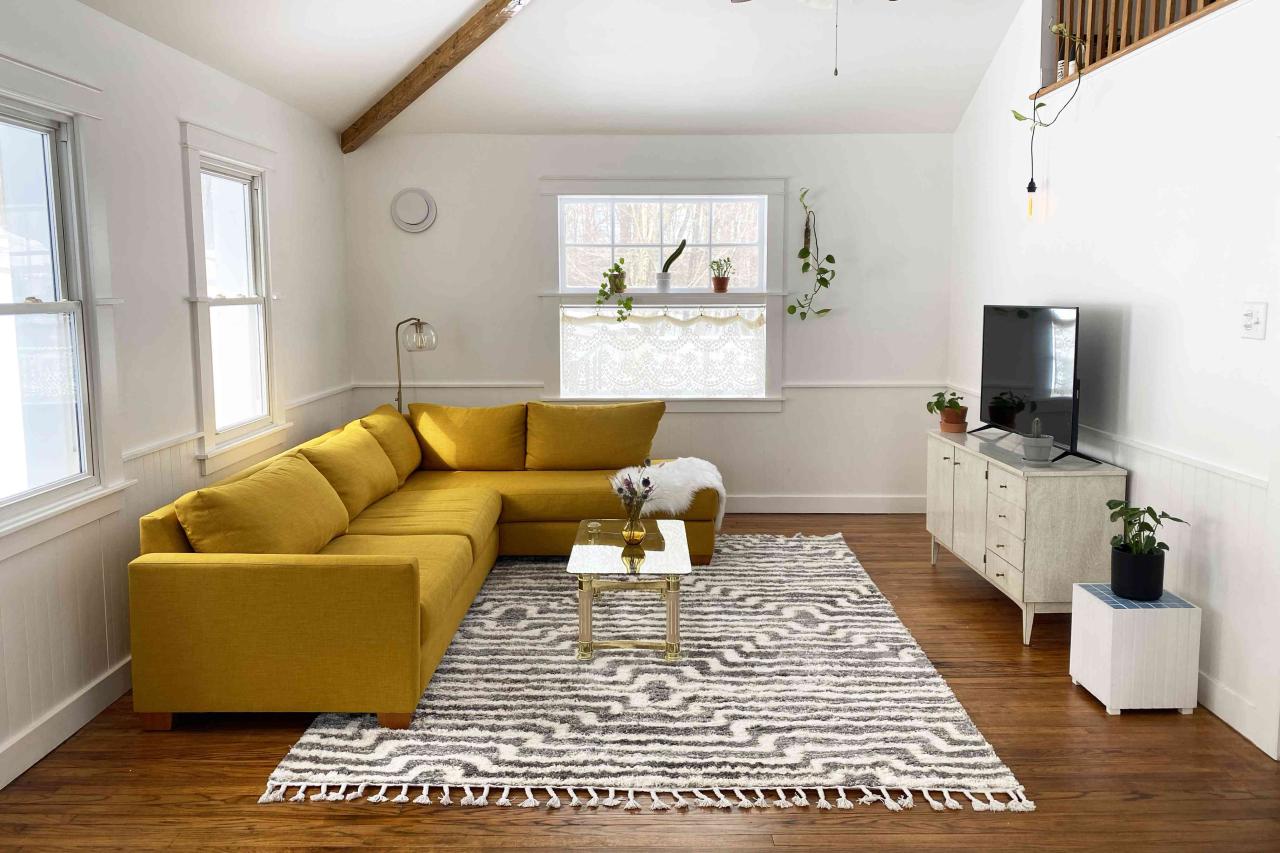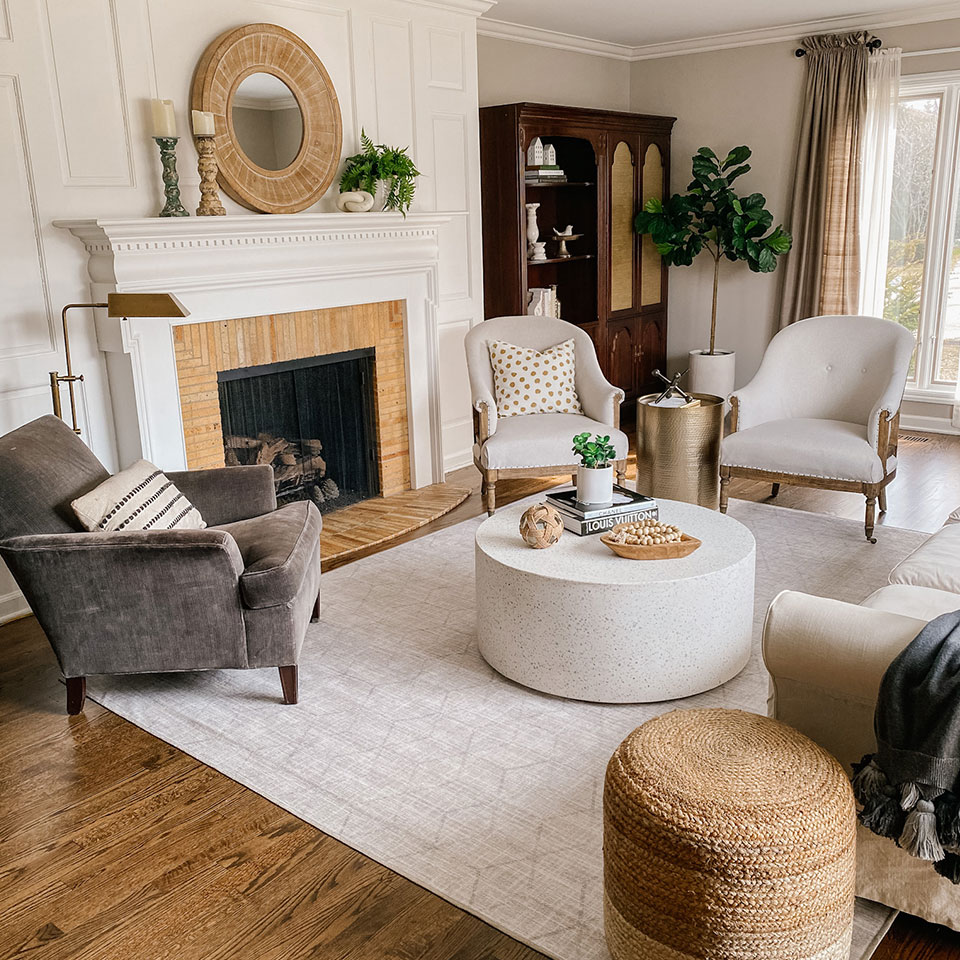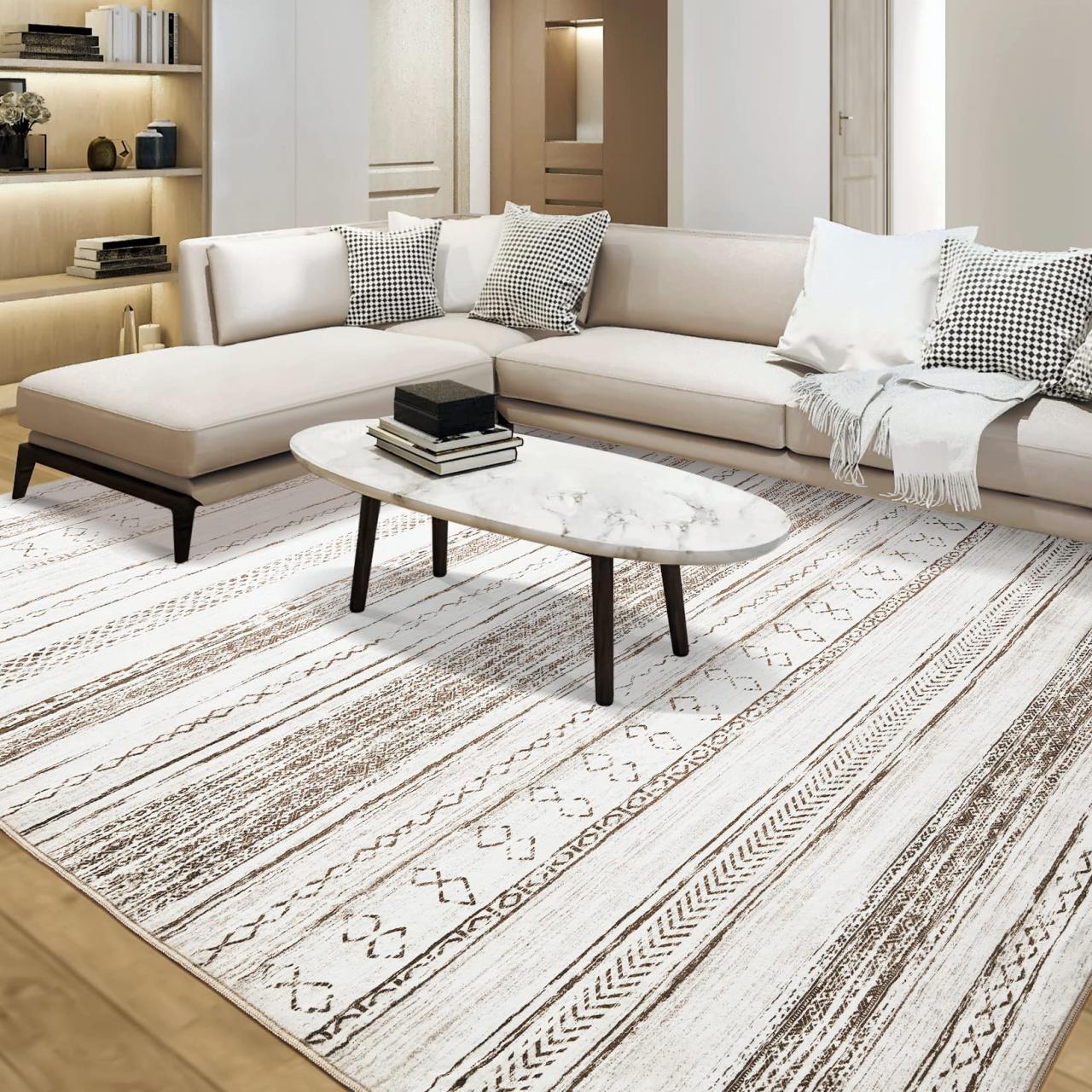Living room rugs: the unsung heroes of interior design! They’re more than just floor coverings; they anchor furniture, define spaces, and instantly elevate the style of your living room. From plush wool to sleek synthetics, the world of rugs offers endless possibilities to personalize your home. This guide dives deep into everything you need to know, from choosing the right size and material to mastering the art of rug placement and care.
We’ll explore various rug styles, from traditional to modern, bohemian to minimalist, helping you find the perfect match for your aesthetic. Discover how different rug materials impact durability, cost, and maintenance, and learn how to select rugs that complement your existing décor and enhance the overall ambiance of your living room. Get ready to transform your space with the power of the perfect rug!
Types of Living Room Rugs
Choosing the right rug can dramatically transform your living room, adding warmth, style, and personality. The sheer variety of materials available, however, can be overwhelming. Understanding the characteristics of different rug materials is key to making an informed decision that complements your existing décor and lifestyle.
Living Room Rug Materials
Selecting the perfect rug material depends on several factors, including your budget, desired aesthetic, and the level of foot traffic your living room experiences. The following table summarizes the key features of popular rug materials.
| Material | Durability | Cost | Maintenance |
|---|---|---|---|
| Wool | High; naturally resilient and durable | High; considered a premium material | Regular vacuuming; professional cleaning recommended |
| Cotton | Moderate; susceptible to wear and tear | Moderate; affordable option | Regular vacuuming; machine washable (some rugs) |
| Silk | Low; delicate and prone to damage | Very High; luxurious and expensive | Professional cleaning only; requires careful handling |
| Synthetic (e.g., Polyester, Nylon) | High to Moderate; varies depending on the specific fiber | Low to Moderate; wide range of price points | Easy to clean; often stain-resistant and durable |
Characteristics of Rug Materials
Wool rugs are renowned for their luxurious texture, inherent softness, and excellent insulation properties. Their natural fibers create a warm and inviting atmosphere, making them ideal for traditional or rustic living room styles. Cotton rugs, on the other hand, offer a more casual and relaxed vibe. Their breathability makes them suitable for warmer climates. Silk rugs exude opulence and sophistication, their shimmering surface adding a touch of elegance to modern or minimalist spaces.
However, their delicate nature requires careful handling. Synthetic rugs provide a versatile option, mimicking the look and feel of natural fibers at a more affordable price point. They are often stain-resistant and easy to maintain, making them a practical choice for busy households.
Natural vs. Synthetic Rug Materials
Natural fibers like wool and cotton offer a unique charm and often possess superior durability and hypoallergenic properties. However, they tend to be more expensive and require more meticulous care. Synthetic rugs, while potentially less luxurious, provide excellent value for money, are generally easier to clean, and offer a wider range of colors and patterns. The choice ultimately depends on your priorities – investing in a high-quality, long-lasting natural fiber rug or opting for the practicality and affordability of a synthetic option.
For instance, a family with young children might prioritize the stain-resistance of a synthetic rug, while a couple seeking a luxurious aesthetic might choose a wool rug.
Rug Sizes and Placement

Choosing the right rug size and placement is crucial for creating a cohesive and visually appealing living room. Getting it wrong can make your space feel cramped or unbalanced, while getting it right can dramatically improve the overall aesthetic and functionality. This guide will help you navigate the often-confusing world of rug sizing and placement, ensuring your living room looks its absolute best.
Selecting the appropriate rug size depends on several factors: the dimensions of your living room, the size and arrangement of your furniture, and the desired visual effect. Generally, larger rugs create a more spacious feel, while smaller rugs can define specific areas within a larger room. Consider the scale of your furniture and the overall proportions of the room to achieve the perfect balance.
Determining Rug Size Based on Living Room Dimensions and Furniture Arrangement
The ideal rug size will depend on your furniture layout. Here are some common scenarios and recommended rug sizes:
- Small Living Room (e.g., 10ft x 12ft): A rug that’s approximately 6ft x 9ft or 8ft x 10ft would work well. This size allows for a portion of the rug to extend beyond the furniture, creating a sense of openness without overwhelming the space. Imagine a small, cozy living room with a sofa and two armchairs arranged in a conversational setting. A 6×9 rug would allow the front legs of the furniture to rest on the rug, while leaving a small border around the edges.
- Medium Living Room (e.g., 12ft x 15ft): An 8ft x 10ft or 9ft x 12ft rug would be suitable. For a larger sectional sofa, you might need a 9×12 or even a larger rug, ensuring at least the front legs of the furniture are on the rug. Picture a living room with a sectional sofa and a coffee table. A 9×12 rug would anchor the furniture group, creating a defined seating area.
- Large Living Room (e.g., 15ft x 20ft): A larger rug, such as a 10ft x 14ft or even a 12ft x 15ft rug, is recommended. In a spacious living room, a larger rug will prevent the furniture from appearing too isolated. Consider a large living room with multiple seating areas. Two smaller rugs could be used to define each area, or one large rug could unite the entire space.
Rug Placement Strategies for Enhanced Visual Appeal and Functionality
The placement of your rug significantly impacts the overall look and feel of your living room. Different placement strategies can achieve various effects.
- All Furniture on the Rug: This creates a more formal and cohesive look, particularly effective in smaller living rooms. It visually grounds the furniture and creates a defined seating area.
- Front Legs on the Rug: This is a popular choice for larger living rooms. It allows for more floor space to be visible while still anchoring the furniture and creating a defined seating area. This approach offers a balance between a formal and casual feel.
- Rug as a Room Divider: In open-plan living spaces, a rug can be used to delineate different zones, such as a seating area and a dining area. This strategy helps to create a sense of separation and organization within a larger space.
Visual Representation of Rug Size Impact on Perceived Space
Imagine three identical living rooms, each with the same furniture arrangement. The difference lies in the rug size:
Scenario 1: A small rug (e.g., 5ft x 7ft) under just the coffee table makes the room feel larger, but the furniture appears somewhat disconnected. The space feels somewhat fragmented.
Scenario 2: A medium-sized rug (e.g., 8ft x 10ft) with the front legs of the sofa and armchairs on the rug creates a balanced and visually appealing arrangement. The room feels comfortably furnished and the furniture is well-anchored.
Scenario 3: A large rug (e.g., 10ft x 14ft) encompassing all the furniture makes the room feel cozier and more unified. The furniture appears grounded and the space feels more intimate, although potentially less spacious.
Rug Styles and Designs: Living Room Rugs
Choosing the right rug style and design is crucial for completing your living room’s aesthetic. The rug acts as a foundational element, influencing the overall mood and feel of the space. Consider your existing décor and the vibe you want to create – whether it’s cozy and traditional or sleek and modern – when selecting your rug. The style you choose will significantly impact the visual harmony of your room.
Living room rugs anchor the space, setting the tone for your entire design. To truly elevate the ambiance, however, you need to consider the lighting; check out this guide on choosing the right luxury home lighting fixtures to complement your rug’s color and texture. The right lighting will make your carefully chosen rug the star of the show, showcasing its beauty and adding warmth to the room.
Different rug styles evoke distinct feelings and suit various interior design preferences. Understanding these styles allows you to make an informed decision that enhances your living space.
Living Room Rug Styles
The style of your rug significantly impacts the overall look of your living room. Here’s a comparison of some popular styles:
| Style | Key Design Features | Color Palette | Materials | Example Decor Pairing |
|---|---|---|---|---|
| Traditional | Ornate patterns, rich textures, often symmetrical designs, detailed craftsmanship. | Deep reds, blues, golds, muted greens | Wool, silk, high-quality synthetics | Antique furniture, ornate mirrors, classical artwork |
| Modern | Clean lines, geometric patterns, minimalist designs, often monochromatic or featuring bold color blocks. | Neutrals, blacks, grays, bold accent colors | Wool, jute, synthetic fibers with a modern look | Mid-century modern furniture, sleek lines, minimalist décor |
| Bohemian | Intricate patterns, layered textures, vibrant colors, eclectic mix of styles and materials. | Earthy tones, jewel tones, vibrant accents | Wool, cotton, silk, often incorporating natural fibers like jute or sisal | Macrame wall hangings, global-inspired furniture, eclectic accessories |
| Minimalist | Simple designs, often solid colors or subtle patterns, focus on clean lines and functionality. | Neutrals, muted tones, single accent color | Natural fibers (jute, cotton), low-pile rugs | Simple, uncluttered furniture, clean lines, neutral color palette |
Rug Patterns and Colors
Rug patterns and colors can either complement or contrast with existing décor, creating different effects. A rug with a similar color palette to your existing furniture can create a cohesive and unified look. For example, a neutral-toned rug in a beige or gray can blend seamlessly with a similarly colored sofa and armchairs. Conversely, a rug with contrasting colors can add a bold pop of color and visual interest.
A vibrant rug in a room with neutral-toned furniture can become a focal point.
Popular Rug Design Motifs and Their Aesthetic Effects, Living room rugs
The choice of rug motif significantly contributes to the room’s overall aesthetic.
Several popular rug design motifs offer unique aesthetic effects:
Geometric patterns often create a modern and sophisticated feel. Clean lines and sharp angles add a sense of order and structure to a space. Geometric rugs are highly versatile and work well in modern, minimalist, and even transitional settings.
Floral patterns bring a sense of romance and elegance. Depending on the style of the floral design, it can range from classic and traditional to whimsical and modern. Floral rugs add a touch of softness and femininity to a space.
Abstract patterns offer a more contemporary and artistic feel. They can add visual interest and a unique touch to a room without being overly dominant. Abstract rugs are ideal for those who prefer a more unconventional look.
Living room rugs instantly elevate a space, adding warmth and personality. Choosing the right one involves considering both aesthetics and practicality; learn more about striking the perfect balance by checking out this guide on incorporating luxury and functionality in home design for inspiration. Ultimately, the ideal rug enhances your living room’s comfort and style, reflecting your personal taste.
Rug Care and Maintenance

Investing in a beautiful living room rug elevates your space, but its longevity depends on proper care. Understanding your rug’s material and employing the right cleaning techniques are crucial for preserving its appearance and extending its lifespan. Neglecting maintenance can lead to premature wear, unsightly stains, and unpleasant odors, ultimately diminishing its aesthetic appeal and value. This section will guide you through effective rug care strategies.
Cleaning Different Rug Materials
Different rug materials require different cleaning approaches. Wool rugs, for example, are delicate and need gentle handling, while more durable materials like polypropylene can withstand more robust cleaning methods. Spot cleaning is ideal for minor spills and stains, while professional cleaning is recommended for deep cleaning and addressing more significant issues.
Spot Cleaning Techniques
For spot cleaning, always act quickly. Blot (don’t rub!) the spill with a clean, absorbent cloth to lift as much liquid as possible. For tougher stains, use a mild detergent solution – a teaspoon of mild dish soap in a cup of cool water is usually sufficient. Apply the solution gently to the stain, blot again, and then rinse with clean water.
Finally, blot the area dry with a clean cloth and allow the rug to air dry completely. Avoid harsh chemicals, as they can damage the rug fibers. For specific stain types (wine, pet accidents, etc.), consult a professional cleaning guide or a specialist.
Professional Rug Cleaning
Professional rug cleaning services offer deep cleaning using specialized equipment and techniques that are often unavailable at home. They can effectively remove embedded dirt, allergens, and stubborn stains. Professional cleaning is particularly recommended for wool, silk, or other delicate rugs, as well as for rugs that have undergone significant soiling. The frequency of professional cleaning depends on factors like foot traffic and the rug material; a yearly cleaning is often recommended for high-traffic areas.
Preventing Rug Damage and Extending Lifespan
Regular maintenance is key to prolonging the life of your rug. This involves a combination of preventative measures and consistent cleaning.
Preventative Measures for Rug Longevity
- Regular Vacuuming: Vacuum your rug regularly, at least once a week, using a vacuum with a beater bar or rotating brush. This removes loose dirt and prevents it from embedding itself in the fibers. For high-pile rugs, consider using a low-setting to avoid damaging the fibers.
- Protective Padding: Using a rug pad underneath your rug protects it from wear and tear, especially on hard floors. The pad also helps prevent slipping and provides cushioning.
- Rotate Regularly: Rotate your rug periodically to ensure even wear. This prevents high-traffic areas from becoming excessively worn.
- Proper Placement: Avoid placing your rug in direct sunlight, as this can cause fading and discoloration. Similarly, avoid placing heavy furniture directly on the rug without using protective pads underneath the legs.
- Immediate Spill Attention: Address spills immediately to prevent them from setting and becoming difficult to remove. The faster you act, the easier it is to clean.
Common Rug Maintenance Issues and Solutions
Several common issues can arise with rugs, but most are manageable with proper care.
Shedding
New rugs often shed initially, as loose fibers are released. Regular vacuuming helps to minimize shedding. For excessive shedding, consider consulting a professional cleaner. In some cases, shedding might indicate a manufacturing defect, which would warrant contacting the retailer.
Staining
Prompt attention to spills is crucial in preventing stains. Different materials react differently to stains, so always test cleaning solutions in an inconspicuous area first. For stubborn stains, professional cleaning is often the best solution.
Odor Removal
Persistent odors can be addressed by airing out the rug, using baking soda to absorb odors, or using specialized rug cleaning products designed for odor removal. Professional cleaning can also effectively eliminate unpleasant smells. For pet odors, enzymatic cleaners are particularly effective.
Living Room Rug Trends

Living room rugs are more than just floor coverings; they’re statement pieces that anchor a room’s design and reflect current interior design trends. Understanding these trends allows homeowners to create stylish and functional spaces that remain relevant for years to come. This section explores current and future trends in living room rug colors, patterns, materials, and the influence of various interior design styles.
The current landscape of living room rug trends showcases a dynamic interplay between classic aesthetics and modern innovations. We’re seeing a move towards more sustainable materials and a broader acceptance of bold design choices, influenced heavily by the ever-evolving world of interior design.
Current Rug Color Trends
Color choices in living room rugs are currently reflecting a desire for both calming neutrals and vibrant pops of color, depending on the overall aesthetic desired. These choices are directly influenced by the dominant color palettes found in popular interior design styles.
- Earthy Tones: Muted greens, browns, and terracotta are incredibly popular, reflecting the ongoing interest in biophilic design and bringing a sense of nature indoors. Imagine a large, plush rug in a deep olive green, complementing a living room with natural wood furniture and plenty of plants.
- Warm Neutrals: Creams, beiges, and soft grays continue to be staples, providing a versatile backdrop for various furniture and décor styles. A large, off-white rug can make a small living room feel more spacious and airy.
- Bold Jewel Tones: Deep blues, rich emeralds, and vibrant ruby reds are making a comeback, adding a touch of luxury and drama to contemporary spaces. A smaller, jewel-toned rug can be a focal point in a minimalist room.
Current Rug Pattern Trends
Rug patterns are mirroring the diverse styles currently dominating interior design. From geometric precision to organic fluidity, the options are vast and reflect individual preferences and stylistic choices.
- Geometric Patterns: Clean lines and bold shapes, such as chevron, stripes, and abstract geometric designs, are popular in modern and minimalist living rooms. A black and white geometric rug can add a touch of sophistication to a contemporary space.
- Organic Patterns: Inspired by nature, these patterns feature flowing lines, botanical motifs, and abstract representations of natural elements. A rug with a leafy pattern could enhance a bohemian or eclectic living room.
- Traditional Patterns: Persian, Oriental, and other traditional patterns continue to be popular, adding a touch of classic elegance to living rooms. A Persian-inspired rug can add warmth and richness to a traditional or transitional space.
Current Rug Material Trends
The materials used in living room rugs are increasingly influenced by a growing awareness of sustainability and a desire for comfort and durability. Consumers are seeking rugs that are both stylish and environmentally responsible.
- Natural Fibers: Wool, jute, sisal, and cotton are gaining popularity due to their eco-friendly nature and inherent durability. A jute rug adds a rustic touch to a farmhouse-style living room.
- Recycled Materials: Rugs made from recycled materials are becoming increasingly common, reflecting a growing commitment to sustainable living. A rug made from recycled plastic bottles offers a stylish and environmentally conscious choice.
- High-Pile Rugs: Plush, high-pile rugs offer exceptional comfort and warmth, creating a cozy atmosphere in the living room. A shag rug adds a luxurious feel to a mid-century modern living room.
Influence of Interior Design Styles on Rug Trends
Current rug trends are deeply intertwined with prevailing interior design styles. The rug becomes a key element in reinforcing the overall aesthetic of the space.
- Mid-Century Modern: Geometric patterns, natural materials like wool, and muted color palettes are favored.
- Bohemian: Layered textures, vibrant colors, and organic patterns are characteristic.
- Scandinavian: Neutral colors, natural fibers like jute or wool, and minimalist patterns are key elements.
- Farmhouse: Natural materials like jute or sisal, neutral colors, and possibly a distressed or vintage look are common.
Future Living Room Rug Trends
Predicting future trends requires analyzing current design directions and emerging consumer preferences. We can expect a continuation of some current trends and the emergence of new ones.
- Increased Focus on Sustainability: The demand for eco-friendly and ethically sourced materials will continue to grow, with more innovative recycled materials appearing on the market. We might see rugs made from seaweed or other unexpected, sustainable materials.
- Personalized Rugs: Customization options, allowing consumers to design their own rugs with unique colors, patterns, and materials, will likely become more prevalent. Think of online platforms offering bespoke rug designs.
- Blending of Styles: Expect to see more eclectic mixes of styles and patterns, with homeowners embracing a more personalized and less strictly defined aesthetic. A living room might feature a traditional rug paired with modern furniture.
Integrating Rugs with Different Decor Styles

Choosing the right rug can dramatically transform your living room, tying the entire space together and enhancing its aesthetic appeal. The key lies in understanding how different rug styles, textures, and colors interact with various interior design themes. Selecting a rug that complements your existing décor will elevate your living room’s overall look and feel, creating a cohesive and stylish environment.
Rug Selection for Farmhouse Decor
Farmhouse style emphasizes rustic charm and natural materials. To achieve this look with your rug, opt for natural fibers like jute, sisal, or wool. These materials offer a tactile warmth and contribute to the overall cozy ambiance. Color palettes should lean towards neutral tones such as creamy whites, soft grays, or muted earth tones. Patterns can include subtle stripes, simple geometric designs, or even a plain, textured surface.
Consider a large jute rug with a distressed finish for a truly authentic farmhouse feel. Avoid overly bright or bold colors; stick to a muted, natural color palette.
Rug Selection for Mid-Century Modern Decor
Mid-century modern design is characterized by clean lines, geometric shapes, and a focus on functionality. Rugs in this style often feature bold geometric patterns or abstract designs. Materials like wool or a low-pile synthetic blend work well, offering a smooth surface that complements the sleekness of the furniture. Color choices often include earthy tones, jewel tones, or even a striking monochrome palette.
A low-pile rug with a geometric pattern in shades of mustard yellow, teal, and navy blue would be a perfect complement to a mid-century modern living room. Avoid overly fluffy or ornate rugs.
Rug Selection for Scandinavian Decor
Scandinavian design prioritizes simplicity, functionality, and a light, airy feel. Rugs in this style often feature natural fibers like wool or cotton in light, neutral colors such as white, cream, beige, or gray. Patterns are typically minimal or absent, allowing the rug’s texture to be the focal point. A simple, textured rug can add warmth and visual interest without overwhelming the space.
A large, fluffy sheepskin rug or a simple, light gray wool rug would enhance the minimalist aesthetic of a Scandinavian living room. Avoid busy patterns or dark colors.
Rug Integration in Different Living Room Layouts
The placement of your rug significantly impacts the overall look of your living room. In open-plan layouts, a large rug can define the living area and create a sense of separation from other spaces. In smaller living rooms, a smaller rug can make the space feel more intimate and cozy. Consider the size and placement of your furniture when choosing a rug.
For example, all legs of your seating area should ideally rest on the rug, or at least the front legs.
Impact of Rug Textures and Colors on Ambiance
The texture and color of your rug have a profound effect on the atmosphere of your living room. A plush, high-pile rug creates a luxurious and cozy feel, while a low-pile rug offers a more modern and minimalist aesthetic. Light, bright colors create a sense of spaciousness and openness, while darker colors can make a room feel more intimate and grounding.
The interplay between rug color and wall color can also significantly influence the overall mood of the space. For instance, a warm-toned rug can complement warm-toned walls, creating a harmonious and inviting atmosphere.